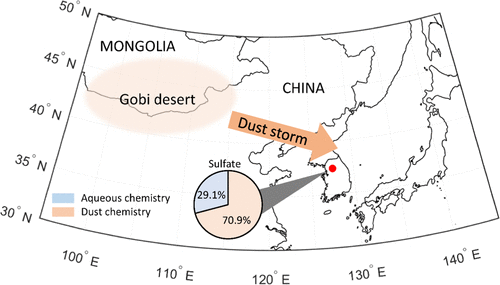当前位置:
X-MOL 学术
›
ACS Earth Space Chem.
›
论文详情
Our official English website, www.x-mol.net, welcomes your feedback! (Note: you will need to create a separate account there.)
Simulating the Impact of Long-Range-Transported Asian Mineral Dust on the Formation of Sulfate and Nitrate during the KORUS-AQ Campaign
ACS Earth and Space Chemistry ( IF 3.4 ) Pub Date : 2020-06-01 , DOI: 10.1021/acsearthspacechem.0c00074 Zechen Yu 1 , Myoseon Jang 1 , Soontae Kim 2 , Changhan Bae 2 , Bonyoung Koo 3 , Ross Beardsley 4 , Jinsoo Park 5 , Lim Seok Chang 5 , Hee Choon Lee 6 , Yun-Kyu Lim 6 , Jeong Hoon Cho 6
ACS Earth and Space Chemistry ( IF 3.4 ) Pub Date : 2020-06-01 , DOI: 10.1021/acsearthspacechem.0c00074 Zechen Yu 1 , Myoseon Jang 1 , Soontae Kim 2 , Changhan Bae 2 , Bonyoung Koo 3 , Ross Beardsley 4 , Jinsoo Park 5 , Lim Seok Chang 5 , Hee Choon Lee 6 , Yun-Kyu Lim 6 , Jeong Hoon Cho 6
Affiliation

|
The atmospheric mineral aerosol reaction (AMAR) model, which was developed to simulate dust-driven heterogeneous chemistry of SO2 and NOx, was combined with the comprehensive air quality model with extensions (CAMx). The resulting model was then applied to simulate the influence of the long-range-transported dust particles on the formation of sulfate and nitrate during the Korean-United States Air Quality (KORUS-AQ) campaign from May 19 to 30, 2016. In the mechanisms, dust particles promoted the oxidation of SO2 and NOx through heterogeneous photocatalytic reactions and autoxidation. The predicted concentrations of sulfate, nitrate, and ammonium ions were compared with ground-based observations obtained at a monitoring site in Olympic Park, Seoul, Korea. The predicted sulfate increased by 29% in the high dust period of this campaign, while the sulfate produced via nondust aqueous reactions decreased by 66%. The model captured the impact of dust on the sulfate formation in that particulate sulfate increased with increasing dust loads. The model also predicted the formation of a large quantity of particulate nitrate during the cold and wet periods in the presence of abundant ammonia in East Asia. The trajectory simulations showed that dust particles were rapidly buffered by sulfate when dust parcels passed urban and industrial areas in Asia and then heavily coated with sulfate and nitrate during long-range transport. The KORUS-AQ campaign was conducted after passing the dust season (i.e., springtime), although dust concentrations were still higher than those in ordinary seasons. Thus, the impact of dust particles on the formation of sulfate and nitrate will be more significant during dust events.
中文翻译:

模拟在KORUS-AQ战役中远距离运输的亚洲矿物粉尘对硫酸盐和硝酸盐形成的影响
大气矿物气溶胶反应模型(AMAR)是为模拟SO 2和NO x的粉尘驱动的异质化学而开发的,它与扩展的综合空气质量模型(CAMx)相结合。然后,将所得模型应用于模拟在2016年5月19日至30日举行的韩美空气质量(KORUS-AQ)活动期间,远程输送的尘埃颗粒对硫酸盐和硝酸盐形成的影响。机理,粉尘颗粒促进了SO 2和NO x的氧化通过异质的光催化反应和自氧化。将预测的硫酸根,硝酸根和铵离子浓度与在韩国首尔奥林匹克公园的监测点获得的地面观测结果进行了比较。在该活动的高尘期中,预测的硫酸盐增加了29%,而通过无尘水溶液反应生成的硫酸盐减少了66%。该模型捕获了粉尘对硫酸盐形成的影响,因为硫酸盐颗粒随粉尘负荷的增加而增加。该模型还预测,在东亚冷水和湿润时期,在有大量氨的情况下,会形成大量硝酸盐颗粒。轨迹模拟显示,当尘埃包裹通过亚洲的城市和工业区时,尘埃颗粒被硫酸盐快速缓冲,然后在远距离运输中被硫酸盐和硝酸盐大量覆盖。尽管尘埃浓度仍高于平常季节,但在经过沙尘季节(即春季)之后进行了KORUS-AQ运动。因此,在粉尘事件期间,粉尘颗粒对硫酸盐和硝酸盐形成的影响将更为显着。
更新日期:2020-07-16
中文翻译:

模拟在KORUS-AQ战役中远距离运输的亚洲矿物粉尘对硫酸盐和硝酸盐形成的影响
大气矿物气溶胶反应模型(AMAR)是为模拟SO 2和NO x的粉尘驱动的异质化学而开发的,它与扩展的综合空气质量模型(CAMx)相结合。然后,将所得模型应用于模拟在2016年5月19日至30日举行的韩美空气质量(KORUS-AQ)活动期间,远程输送的尘埃颗粒对硫酸盐和硝酸盐形成的影响。机理,粉尘颗粒促进了SO 2和NO x的氧化通过异质的光催化反应和自氧化。将预测的硫酸根,硝酸根和铵离子浓度与在韩国首尔奥林匹克公园的监测点获得的地面观测结果进行了比较。在该活动的高尘期中,预测的硫酸盐增加了29%,而通过无尘水溶液反应生成的硫酸盐减少了66%。该模型捕获了粉尘对硫酸盐形成的影响,因为硫酸盐颗粒随粉尘负荷的增加而增加。该模型还预测,在东亚冷水和湿润时期,在有大量氨的情况下,会形成大量硝酸盐颗粒。轨迹模拟显示,当尘埃包裹通过亚洲的城市和工业区时,尘埃颗粒被硫酸盐快速缓冲,然后在远距离运输中被硫酸盐和硝酸盐大量覆盖。尽管尘埃浓度仍高于平常季节,但在经过沙尘季节(即春季)之后进行了KORUS-AQ运动。因此,在粉尘事件期间,粉尘颗粒对硫酸盐和硝酸盐形成的影响将更为显着。


























 京公网安备 11010802027423号
京公网安备 11010802027423号